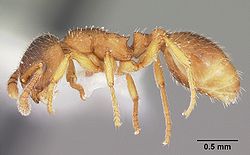| Formicoxenus quebecensis | |
|---|---|
 | |
| Formicoxenus quebecensis worker | |
| Scientific classification | |
| Kingdom: | Animalia |
| Phylum: | Arthropoda |
| Class: | Insecta |
| Order: | Hymenoptera |
| Family: | Formicidae |
| Subfamily: | Myrmicinae |
| Genus: | Formicoxenus |
| Species: | F. quebecensis |
| Binomial name | |
| Formicoxenus quebecensis Francoeur, in Francoeur, Loiselle & Buschinger, 1985 | |
Formicoxenus quebecensis is a species of ant in the genus Formicoxenus . It is endemic to Canada. [1]
